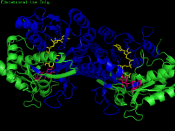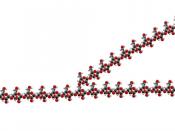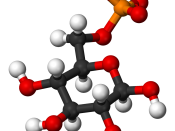DISCUSS HOW GLYCOGEN IS SYNTHESISED
GENERAL STRUCTURE INFORMATION
Glycogen comprises polymers of glucose, linked by á 1-4 glycosidic bonds. The branch points are linked by á 1-6 glycosidic bonds. The branch points occur at 8, 9 or 10 residue spacings along the linear chain.
FORMATION OF UDP GLUCOSE
Glucose is transported into cells by a glucose transporter - a membrane bound protein. It is phosphorylated to form glucose-6-phosphate. This is catalysed by hexokinase. ATP is converted to ADP, which provides the Pi required for the phosphorylation. Isomerisation of glucose-6-phospate forms glucose-1-phosphate. This is catalysed by phosphoglucomtase. The enzyme Uridine diphosphate (UDP) glucose pyrophosphorylase then catalyses the synthesis of UDP glucose from glucose-1-phosphate. UDP glucose is the metabolically active version of glucose, i.e. the form of glucose which is appropriate for glycogen synthesis. This conversion must occur before glycogen can be synthesised.
Glucose
Hexokinase
Glucose-6-phosphate
Phosphoglucomutase
Glucose-1-phosphate
UDP glucose pyrophosphorylase
UTP
PPi
UDP Glucose
H2O
2 Pi
MAINTENANCE OF FORMATION OF GLYCOGEN
Pyrophosphate (PPi) formed in this reaction step is hydrolysed to form two orthophosphate (Pi) species.
This enzymatic cleavage is mediated by pyrophosphatase. This step is highly exergonic - about 30kJmol-1 under standard conditions. This step is relevant to glycogen synthesis since it draws the reaction (UDP-glucose formation from glucose-1-phosphate) to the right, maintaining the formation of UDP-glucose and hence the formation of the glycogen polymer.
FORMATION OF GLYCOGEN FROM UDP GLUCOSE
UDP-glucose donates its glucosyl moiety (the activated sugar unit) to the non-reducing end of a glycogen branch. The glycogen branch must comprise at least 4 residues of glucose. This addition reaction generates an á 1-4 glycosidic linkage - so called because the link forms between the carbon 1 of the incoming glucosyl moiety and carbon 4 of the glucose residue at the terminus of the chain. Glycogen synthase...


